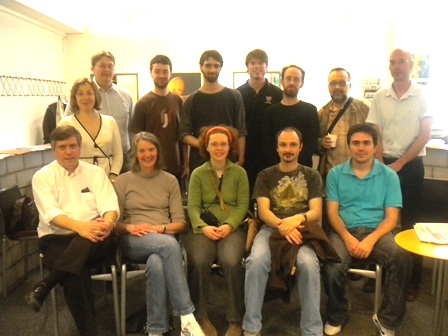Mining and exploiting the NASA Solar Dynamics Observatory data in Europe
The Dream Team

Meeting pages
Purpose
The NASA SDO (Solar Dynamics Observatory) space mission is extraordinary in many ways. Its three solar instruments, AIA, HMI and EVE, push the technology and in particular the production rate of data to extreme values. For example, the SDO-AIA telescope built by LMSAL will produce by the end of 2009 a 4k x 4k image every five seconds for each of it four telescopes (10 spectral bands). Such performance is eminently justified on the scientific level, and SDO will enable many discoveries in our field. However, at about two TB per day of data, old ways of looking at the data will not be practical anymore. Mining SDO data, representing them meaningfully, and creating useful metadata require automatic tools based sometimes on advanced mathematical techniques.
Our International Team spans a wide range of expertise in the development of software for the pre-processing or post-processing of solar data. The purpose of this International Team will be to compare different algorithms having a same purpose, to discuss the desired outputs and their operational implementation in data centers. We will also seek how to combine different algorithms in order to enlarge their scope and potentially define new meaningful representation. Finally, we will study solar eruptions and the possibility to have early prediciton. This subject has impacts both on Space Weather applications, as well as on the understanding of the physics underlying solar eruptions.
Publications
C. Verbeeck, P.A. Higgins, T. Colak, F.T. Watson, V. Delouille, B. Mampaey, R. Qahwaji,
A Multi-wavelength Analysis of Active Regions and Sunspots by Comparison of Automatic Detection Algorithms,
Solar Physics, Online First, Oct. 2011. pp. 369-.
O.W. Ahmed, R. Qahwaji, T. Colak, P.A. Higgins, P.T. Gallagher, D.S. Bloomfield,
Solar Flare Prediction Using Advanced Feature Extraction, Machine Learning, and Feature Selection,
Solar Physics, Online First, Nov. 2011, pp. 404-
T. Dudok de Wit, S. Moussaoui, C. Guennou, F. Auchère, G. Cessateur, M. Kretzschmar, L.A. Vieira, F.F. Goryaev,
Coronal Temperature Maps from Solar EUV images: a Blind Source Separation Approach,
To appear in Solar Physics, 2012.
T. Dudok de Wit, Extracting individual contributions from their mixture:
a blind source separation approach, Contributions to Plasma Physics Vol 51
(2011) pp 143-151, doi:10.1002/ctpp.201000052
P.A. Higgins, P.T. Gallagher, R.T.J. McAteer, and D.S. Bloomfield,
Solar magnetic feature detection and tracking for space weather monitoring,
Advances in Space Research Vol 47 (2011) pp 2105-2117, doi: 10.1016/j.asr.2010.06.024
N. Labrosse, S. Dalla, S. Marshall, Automatic Detection of Limb Prominences in 304 A EUV Images,
Solar Physics, Vol 262 (2010). pp. 449-460. ISSN 0038-0938.
Team Members
- Frédéric Auchère, Institut d’Astrophysique Spatiale, Orsay, FR
- Véronique Delouille, Royal Observatory of Belgium, BE, (Leader)
- Thierry Dudok de Wit, LPC2E, Université d'Orléans, FR
- Peter Gallagher, Trinity College Dublin, IR
- Jean-François Hochedez, Royal Observatory of Belgium, BE
- Davina E. Innes, Max-Planck-Institut für Sonnensystemforschung,GE
- Matthieu Kretzschmar, LPC2E, Université d'Orléans, FR
- Nicolas Labrosse, University of Glasgow, UK
- Petrus Martens, Harvard-Smithsonian Center for Astrophysics, USA
- Susanna Parenti, Institut d’Astrophysique Spatiale, Orsay, FR
- Rami Qahwaji, Bradford University, UK
- Karel Schrijver, Lockheed Martin Advanced Technology Center, USA
- Robert Walsh, University of Central Lancashire, UK
Young scientists
- Tufan Colak, Bradford University, UK
- Paul Higgins, Trinity College Dublin, UK
- Alec Engell, Harvard-Smithsonian Center for Astrophysics, USA
- Catherine Timmermans, Université catholique de Louvain, BE
- Fraser Watson, University of Glasgow, UK
Visitors
- Stéphane Régnier, Now at University of Central Lancashire, UK
- Silvia Dalla, University of Central Lancashire, UK
- Roman Brajša, University of Zagreb, Croatia
- Justin Kasper, Harvard-Smithsonian Center for Astrophysics, USA
- Cis Verbeeck, Royal Observatory of Belgium, BE
List of keywords for the HEK
List of keywords for feature recognition modules (FRM) that will export to the Heliophysics Event Knowledge base:
-
STARA, Sunspot Tracking And Recognition Algorithm, FRM for sunspot in continuum images
- SMART, SolarMonitor Active Region Tracking, FRM for Active Region on magnetogram
- ASAP, Automated Solar Activity Prediction, FRM for sunspot in continuum images, and active region in magnetogram
- SPoCA, Spatial Possibilistic Clustering Algorithm, FRM for Active Region and Coronal Holes in EUV images
- SOPRA, Solar Off-limb Prominence Reconstruction Algorithm FRM for prominence detection in 304A channel.
Subsistence
Since good work needs some good food, here are some suggestions from another ISSI team to get some subsistence in the evening
Veronique Delouille
Last modified: 2012-04-16

